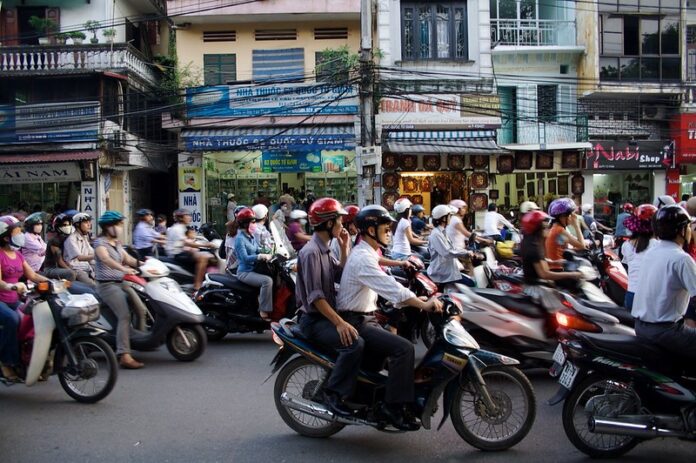South Asia, Africa and other countries in the Global South are poised to adopt the electric two-wheeler (E2W) as the primary means of transportation for daily commutes. The South Asian countries of India, Vietnam, Thailand, Malaysia, Cambodia, Laos and Indonesia are not just adopting E2Ws but also becoming their primary manufacturers.
India is expected to be the world’s biggest market for E2Ws by 2030. That’s because of the familiar traffic scenes similar to the picture that appears at the top of this article, streets crammed with two-wheelers. African street scenes look similar.
That’s not the state of transportation in Europe and North America. There, cars predominate, as do their manufacturers. That is a reason why neither continent has the manufacturing capacity to penetrate the growing, upwardly mobile populations in the Global South. The growing electromobility of the Developed World isn’t presently meeting the transportation demand needs for the nations of the Developing World where two-wheelers and three-wheelers (the Tuk Tuks, the auto rickshaw three-wheeled motorized vehicles commonly used for taxis and service transportation in many parts of the world seen in episodes of The Amazing Race) prevail.
That is not to say that the Global South is devoid of car manufacturers. There are recent forays into this market space of the four-wheel EV kind. Among those taking the first steps is Vietnam’s VinFast. China’s BYD is also trying to expand market share in the Global South by introducing lower-priced EV models. But for now, the roads of the Global South, Southeast Asia in particular, are clogged with hundreds of millions of motorcycles with car totals a pittance.
South Asian companies have taken the lead in manufacturing 2EWs. Many of these companies are traditional motorbike and car manufacturers. They see the growth opportunities as enormous. For example:
- In Indonesia, the market is expected to grow to $20 billion by 2029 with more than 50% of EVs being E2Ws.
- Rahul Gupta, of McKinsey and Associates, at a G20 summit last year stated that E2Ws would have a 50% transportation market share in Southeast Asia by 2030.
- India’s burgeoning E2W market is expected to grow more than 500% from 2024 to 2030 and be worth $3.4 billion annually. The number of new motorbikes, the majority being E2Ws, will reach 22 million annually.
Similar explosive growth is forecast for other South Asian and African markets.
The reasons for E2Ws predominating on the roads of the Global South include:
- Two-wheelers are cheaper to produce and cheaper to buy.
- Traffic congestion makes two-wheelers a better choice than four-wheelers for getting around clogged urban streets.
- Air pollution in South Asian and African cities makes E2Ws an attractive alternative to gas-powered two-wheelers.
- Chaotic and informal road infrastructure makes two-wheelers more versatile for navigating transit.
Do these countries of the Global South need autonomy features for their E2Ws? Some experts believe that adding autonomous features to E2Ws could make traffic on Global South roads more navigable. Autonomous two and three-wheelers could prove to be more efficient when addressing congestion issues and could be outfitted with software capable of dealing with the unique traffic conditions and road infrastructure in Global South countries.
Adding autonomous features, however, could make E2W pricing beyond the reach of the majority of Global South consumers. The challenge for E2Ws, whether autonomous or not, may be further limited by a lack of charging infrastructure. Even in the Global North, at present, the lack of a comprehensive charging network, continues to limit widespread adoption of four-wheeled EVs, let alone E2Ws. And finally, the lack of a regulatory framework within Global South countries, may also impact autonomous E2W adoption.
One thing is certain, the Global South is a market undergoing transformative change. If the telecommunications model is one to guide autonomous E2W suppliers in Global South countries, then the mobility models that exist in the Global North, need not be copied. Global South countries have adopted mobile telephone networks rather than going through the stages of landline network infrastructure development that preceded cellphones in the Global North. The potential to leapfrog these traditional norms may lead to an E2Ws, Tuk Tuk and autonomous transportation Global South revolution.









